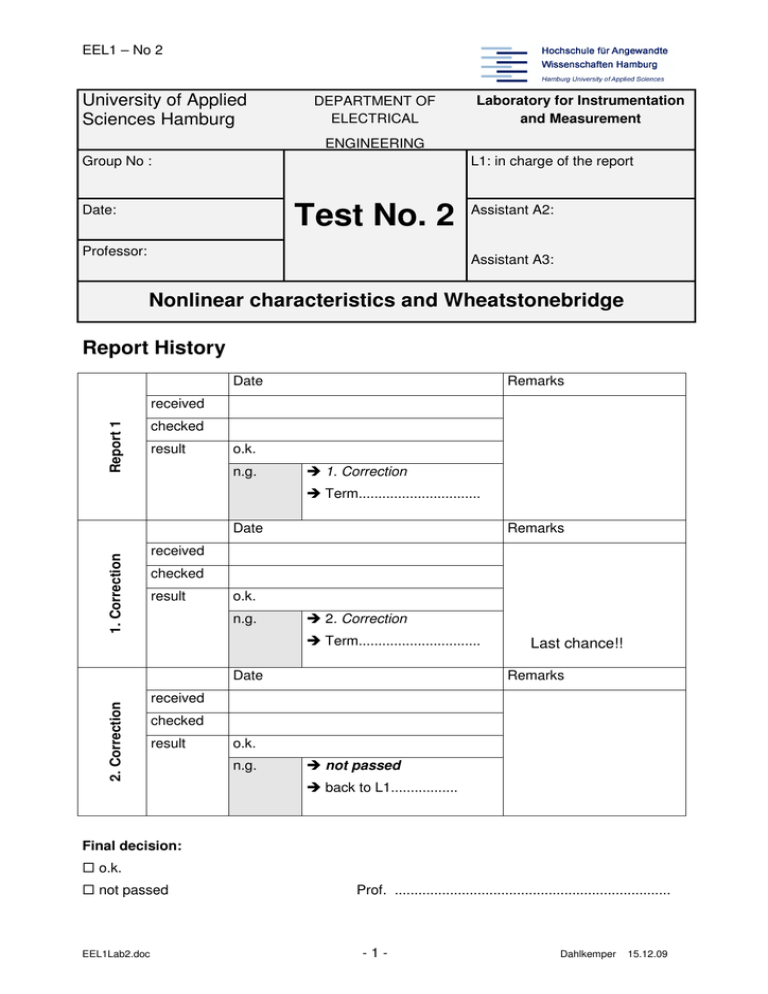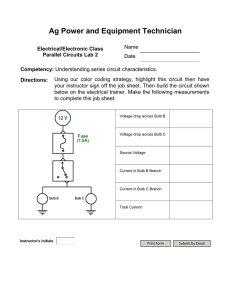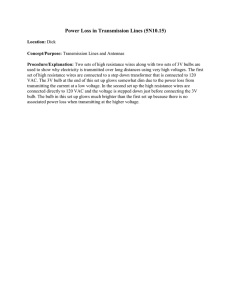Test No. 2 - HAW Hamburg
advertisement

EEL1 – No 2 University of Applied Sciences Hamburg DEPARTMENT OF ELECTRICAL Laboratory for Instrumentation and Measurement ENGINEERING Group No : L1: in charge of the report Test No. 2 Date: Professor: Assistant A2: Assistant A3: Nonlinear characteristics and Wheatstonebridge Report History Date Remarks Report 1 received checked result o.k. n.g. 1. Correction Term............................... 1. Correction Date Remarks received checked result o.k. n.g. 2. Correction Term............................... 2. Correction Date Last chance!! Remarks received checked result o.k. n.g. not passed back to L1................. Final decision: o.k. not passed EEL1Lab2.doc Prof. ...................................................................... -1- Dahlkemper 15.12.09 EEL1 – No 2 Objectives • Understand the characteristics of non-linear resistances, especially the differential resistance at operating point • Become familiar with the presentation of measured data in linear and logarithmic scaling • Application of the Wheatstone bridge and understanding of the balanced and unbalanced bridge equations, sensitivity and linearity • Critical analysis of the data and comparison with the theoretical precalculated values. Preparation Note: This homework is to be prepared as group work before the lab session starts and to be presented at the beginning of the lab session by the team leader. 1. Non-linear current characteristic Let: I U = a mA V b (formula 1) with a = 40 and b = 0.50 Calculate the current for the following voltages: 0.1V, 0.5V, 0.8V, 2.0V and 6.0V. 2. Unbalanced bridge (see fig.1) Let R2 = 1 kΩ; R3 = R4 =10 kΩ and UB = 6 V. Calculate the bridge voltage UD(R1) for R1 from 500Ω to 1800Ω with an increment of 100Ω! Present the calculated values in the following scale on grid paper: UD (ordinate): 100 mV/cm, R1 (abscissa): 100 Ω/cm. EEL1Lab2.doc -2- Ω R1 R3 R1 UB V R2 UD R4 fig. 1 Dahlkemper 15.12.09 EEL1 – No 2 Experiment 1: Measurement of non-linear elements By simultaneous measurement of current and voltage of electronic elements their characteristics are to be measured step by step. The data must be presented graphically. In order to fully exploit the range of the variable voltage source, the circuit is to build up with a voltage divider. The specific arrangement has to be highlighted in the (prepared) circuit diagram. Light bulb Nominal values of light bulb: 6 V / 0,6 W a) Measure the voltage across the bulb and the current through it in the voltage range 6 V to 0.01V. List the data in a table (10 to 15 measuring points). To adjust the voltage use the adjustable power supply (maximum voltage is 10 V). Protect the light bulb with a resistor so it cannot be destroyed. b) Make a plot of the I = f(U) characteristic in a lin-lin scaling and determine graphically the DC resistance R and the incremental resistance r at the operating points U = 0.3 V, 2.0 V and 5.0 V. List the results in the table below! U/V I /mA R /Ω Ω r /Ω Ω 0.3 2.0 5.0 c) Make a plot of the I = f(U) characteristic in a log-log scaling. d) In the voltage range 0.8V < U < 6V the characteristic is to be approximated by the functional expression given in formula 1. Present the pre-calculated values in a log-log diagram. I U = a mA V b (formula 1) e) Approximate the data of the log-log diagram in the range 0.8V < U < 6V only by a regression line („best straight line“). f) Determine the parameters „b“ and „a“ graphically from the „best straight line“. g) Proof the result of „b“ and „a“ by means of formula 1 at U = 0.8V and 5.0V. Is the calculated data in agreement with the measured ones? h) Measure the resistance of the „cold“ bulb and document the value and the applied instrument. EEL1Lab2.doc -3- Dahlkemper 15.12.09 EEL1 – No 2 Experiment 2: Wheatstone bridge a) Build up the circuit of figure 1 in which R2, R3 and R4 are (precise) decade resistances. R1 is a so called tandem-potentiometer consisting of two identical potentiometers on the same axis from which one potentiometer has to be directly connected to an ohmmeter. Ω R1 UB R3 R1 V R2 UD R4 fig. 1 Let: R2 = 1 kΩ; R3 = R4 = 10 kΩ and UB = 6 V. b) Determine that value of R1 at which the bridge is balanced. This value is named as R1,0. c) Measure the voltage UD as a function of R1 for the following values: R1 = 550 Ω, 750 Ω, 1.0 kΩ, 1.25 kΩ, 1.4 kΩ , 1.7 kΩ and 2.0 kΩ! d) Document all values in a table together with the relative unbalance r = ∆R/R1,0 where ∆R = R1 − R1,0. e) Make a graph of the relationship UD = f(R1) and highlight in this diagram the pre-calculated values. f) Construct the tangent in the UD = f(R1) graph at the balance point and determine the bridge sensitivity E0 at this particular point and compare it with the theoretical value. EEL1Lab2.doc -4- Dahlkemper 15.12.09




